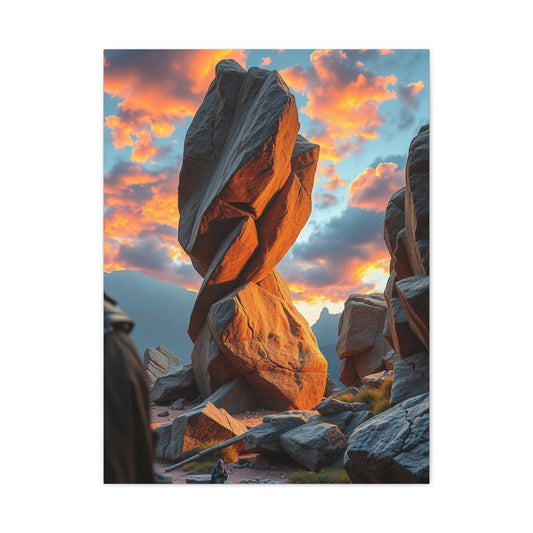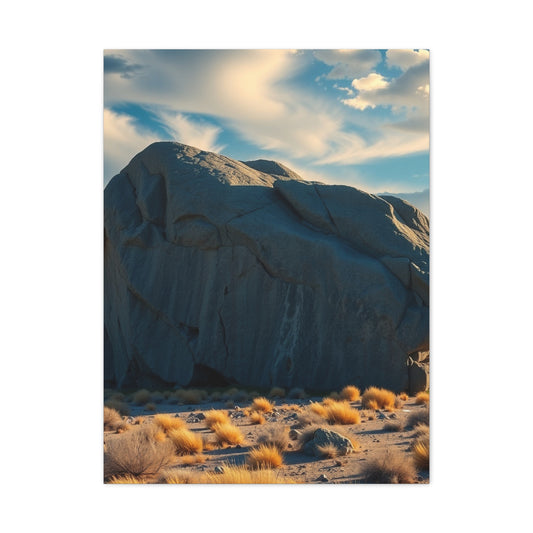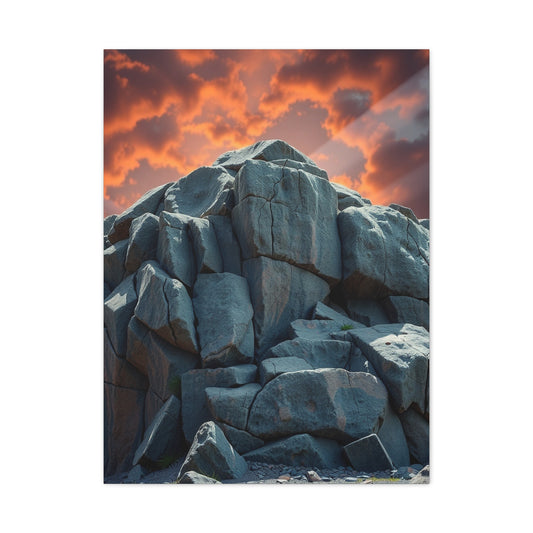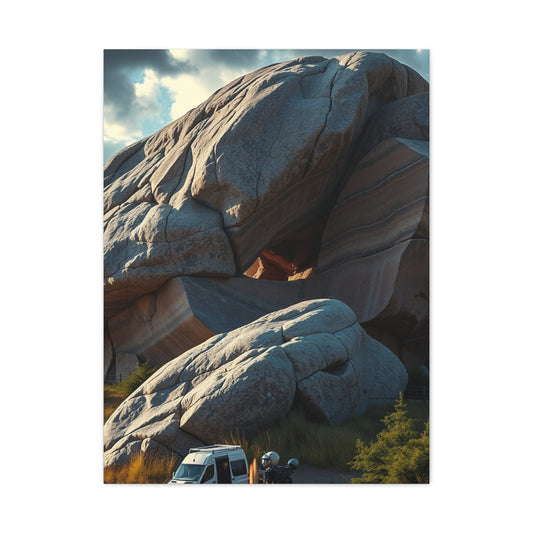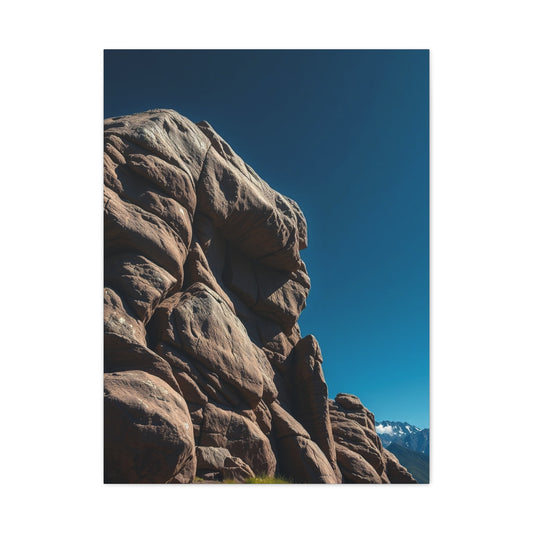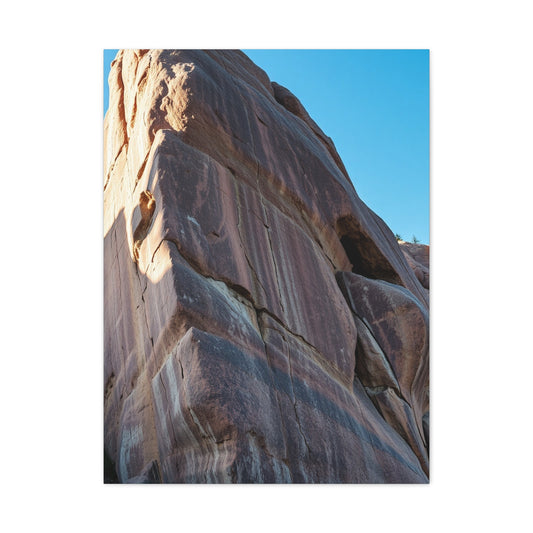Boulder Wall Art Design: Harmonizing Natural Elements with Contemporary Aesthetics
Boulder wall art stands as a remarkable testament to the harmony between nature and human craftsmanship, bridging the gap between raw natural elements and refined contemporary design. Unlike synthetic materials or mass-produced décor, boulders carry with them a sense of permanence, history, and natural grandeur. Their presence within living or working spaces does more than add visual appeal—it infuses the environment with grounding energy, a timeless aesthetic, and an undeniable sense of strength. By carefully selecting, shaping, and arranging these stones, designers transform them into monumental works of art that transcend simple decoration, instead becoming focal points that define the character of a space.
One of the most striking qualities of boulder wall art lies in its ability to seamlessly integrate indoor and outdoor environments. When placed in gardens, courtyards, or exterior facades, these installations echo the natural surroundings, reinforcing the bond between architecture and landscape. Indoors, they introduce an organic element into otherwise structured environments, softening rigid lines and modern materials such as glass and steel with the raw texture of stone. This fusion creates a balanced design language where nature is not just a backdrop but an active participant in shaping the ambiance.
Beyond aesthetics, boulder wall art also embraces functionality. Large stone surfaces can serve as acoustic buffers, thermal regulators, or even structural reinforcements, contributing to the overall efficiency of a building. Their durability ensures longevity, making them a sustainable investment that resists weathering, erosion, and time. In many cultures, stone has been associated with resilience and permanence, and incorporating it into modern spaces revives these symbolic meanings, enriching the narrative behind each installation.
Equally important is the cultural and historical dimension of boulder wall artistry. Stone-working traditions date back thousands of years, from ancient monoliths and temple walls to medieval fortifications and sacred monuments. Contemporary designers often draw inspiration from these legacies, blending ancestral techniques with modern tools to craft installations that honor the past while serving present-day lifestyles. This interplay between tradition and innovation underscores the enduring relevance of stone in human expression, reminding us that natural materials hold timeless appeal in an ever-changing design world.
Ultimately, boulder wall art represents more than just an architectural choice—it is a philosophy of design that values authenticity, durability, and connection to the earth. By embracing the raw magnificence of natural stone, contemporary spaces achieve not only visual distinction but also emotional resonance, grounding occupants in an environment that feels at once modern and eternal. It is this duality—ancient and contemporary, decorative and functional—that makes boulder wall art one of the most compelling and transformative trends in modern design.
Stone Masonry in Wall Art and Design
Stone masonry has always been more than a building technique—it is an artistic language that bridges human creativity with the permanence of nature. The use of massive stones in wall art and design embodies both technical ingenuity and cultural expression, tracing its roots back thousands of years. From the awe-inspiring monuments of ancient civilizations to the serene landscapes shaped by Asian traditions, boulder-based artistry reflects humanity’s enduring fascination with strength, balance, and timeless beauty.
Each era brought unique innovations: prehistoric builders revealed the symbolic power of monumental stones; Egyptian architects showcased precision and monumental scale; Greek and Roman designers emphasized proportion and decorative harmony; medieval stonemasons transformed structural necessity into artistic grandeur; and Asian traditions elevated stone placement into a philosophy of environmental integration.What makes stone masonry so remarkable is its adaptability across cultures and centuries. Despite the absence of modern machinery, ancient craftsmen developed sophisticated systems for quarrying, transporting, and fitting stones with incredible precision.
Their creations were not just functional structures but also cultural artifacts that embodied spirituality, identity, and artistic vision. These innovations have endured as guiding principles for today’s designers, who continue to draw upon this heritage when creating modern boulder wall installations. Whether it is the grandeur of a cathedral wall, the elegance of a Roman forum, or the meditative balance of a Japanese garden, each example highlights how stonework can merge technical mastery with symbolic depth.In contemporary wall art and design, stone masonry carries forward these traditions while adapting to modern aesthetic and functional needs.
Today’s designers utilize ancient techniques alongside advanced technology to craft installations that are both sustainable and visually striking. The emphasis on texture, proportion, and environmental harmony remains central, echoing principles established centuries ago. Modern boulder wall artistry not only celebrates the raw beauty of natural stone but also serves as a reminder of the resilience, permanence, and cultural continuity it represents. By honoring historical practices while embracing new innovations, contemporary stone masonry creates enduring installations that connect modern spaces to the timeless artistry of the past.
Choosing the Right art Design
Choosing the right design for boulder wall art requires more than just aesthetic judgment; it demands a comprehensive understanding of geology, sustainability, and artistic vision. The stones selected for these installations must balance visual appeal with durability, availability, cost, and environmental impact. Each stone type carries distinct characteristics that shape both the artistic outcome and the long-term performance of the installation, making material selection one of the most critical stages of the creative process. Granite remains one of the most sought-after choices for boulder wall installations.
Renowned for its exceptional durability and resistance to weathering, thermal fluctuations, and chemical erosion, granite ensures lasting structural integrity. Its wide availability and stunning natural variations in color and texture make it versatile enough for both raw, organic designs and polished, refined finishes. Designers often highlight weathering patterns, lichen growth, or polished surfaces to create specific aesthetic effects that complement both indoor and outdoor environments.Sandstone, by contrast, offers a softer, more welcoming feel. Known for its earthy tones and ability to weather gracefully, it provides an approachable warmth to installations. Its relative softness makes it easier to shape, carve, and texture, offering flexibility to designers who wish to add unique artistic details.
Sandstone’s porous structure also supports vegetation growth, allowing the creation of living boulder walls where plants become part of the overall artistic composition, blending the natural and the architectural. Limestone brings another layer of uniqueness, often containing fossils or mineral inclusions that not only add character but also educational value to the design. Its light coloration provides a striking contrast when paired with darker stones, and its workability makes it ideal for installations requiring intricate detailing.For bold and dramatic expressions, volcanic rocks such as basalt and lava stone are highly valued. Their deep, dark hues and distinctive textures—whether cellular patterns or flow formations—create strong visual statements.
These stones carry geological stories that enhance their artistic significance, offering designs that are as intellectually stimulating as they are visually striking. River rocks and fieldstones, meanwhile, provide a more organic, regional character. Naturally weathered over millennia, these stones feature soft edges, unique textures, and an authenticity that integrates seamlessly with landscape settings. Their local availability reduces transportation costs and environmental impact, making them a practical yet aesthetically rich option.
Design Methodologies and Planning Approaches
Successful boulder wall art projects require systematic design methodologies that address multiple complex variables while maintaining creative flexibility. Contemporary practitioners utilize sophisticated planning approaches that combine traditional design principles with modern technological tools to ensure optimal outcomes. These methodologies emphasize thorough site analysis, careful material selection, precise engineering calculations, and detailed construction planning.
Site analysis forms the foundation of successful boulder wall design, requiring comprehensive evaluation of topographical features, soil conditions, drainage patterns, existing vegetation, architectural context, and environmental factors. Understanding these site-specific variables enables designers to create installations that work harmoniously with existing conditions while achieving desired aesthetic and functional objectives. Detailed site documentation including photographs, measurements, and environmental assessments provides essential reference information throughout the design process.
Conceptual design development begins with exploring various compositional approaches and aesthetic directions through sketches, collages, and three-dimensional studies. These preliminary explorations help establish overall design intentions while identifying potential challenges and opportunities. Contemporary practitioners often utilize digital modeling tools to test different arrangements and visualize how proposed installations will appear under various lighting conditions and seasonal changes.
Technical design development requires precise engineering calculations to ensure structural stability and safety. Boulder wall installations must accommodate significant loads, lateral pressures, and dynamic forces while maintaining their artistic integrity. Professional structural engineers work closely with designers to develop appropriate foundation systems, reinforcement strategies, and connection details that provide necessary strength without compromising aesthetic objectives.
Construction documentation includes detailed drawings, specifications, and installation procedures that guide implementation while ensuring quality control. These documents specify exact stone sizes, positioning requirements, connection methods, and finishing techniques while providing clear guidance for contractors and installers. Comprehensive documentation prevents misunderstandings and ensures that artistic visions are accurately translated into physical reality.
Material procurement planning addresses sourcing, transportation, and staging requirements for boulder installations. Large stones require specialized equipment and logistics coordination, making advance planning essential for project success. Contemporary practitioners develop detailed procurement schedules that coordinate material delivery with construction activities while minimizing site disruption and storage requirements.
Quality assurance protocols ensure that completed installations meet design intentions and performance requirements. These procedures include material inspections, installation monitoring, and final evaluations that verify structural adequacy and aesthetic quality. Systematic quality control prevents problems while ensuring that clients receive installations that meet or exceed their expectations.
Architectural Integration and Spatial Relationships
Boulder wall art installations achieve maximum impact when thoughtfully integrated with surrounding architectural elements and spatial relationships. Successful integration requires careful consideration of scale relationships, material harmonies, visual connections, and functional interactions that create cohesive design experiences. Contemporary practitioners understand that boulder walls function most effectively as integral components of larger design compositions rather than isolated artistic elements.
Scale relationships between boulder installations and surrounding architectural features significantly influence perceived harmony and visual impact. Massive stones can overwhelm delicate architectural details while small stones may appear insignificant in relation to large buildings. Successful designers carefully calibrate stone sizes and arrangements to create appropriate proportional relationships that enhance rather than compete with existing architectural elements.
Material harmonies involve coordinating stone selections with existing building materials, hardscape elements, and landscape features. Boulder installations should complement rather than clash with surrounding materials while maintaining their own distinct character. This coordination might involve selecting stones that echo colors found in building facades, choosing textures that relate to paving materials, or incorporating surface treatments that reference nearby architectural details.
Visual connections between boulder walls and surrounding spaces help create unified design experiences that feel naturally integrated rather than artificially imposed. These connections might involve aligning wall elements with architectural features, creating sight lines that frame desirable views, or establishing rhythmic patterns that relate to building proportions. Thoughtful visual integration ensures that boulder installations enhance their environments rather than appearing disconnected or inappropriate.
Functional interactions address how boulder wall installations support intended uses while complementing surrounding activities and circulation patterns. Seating areas incorporated into boulder walls should relate appropriately to adjacent gathering spaces, pathways should flow naturally around wall installations, and privacy screens should provide appropriate separation without creating unwanted isolation. These functional considerations ensure that artistic installations also serve practical needs effectively.
Lighting integration requires careful coordination between boulder wall installations and surrounding illumination systems. Natural stone surfaces respond dramatically to different lighting conditions, creating opportunities for spectacular nighttime effects while requiring careful consideration of shadow patterns and glare control. Contemporary practitioners often incorporate LED systems directly into boulder installations, creating dramatic uplighting effects while maintaining daytime visual integrity.
Environmental integration involves harmonizing boulder installations with surrounding landscape features, drainage patterns, and ecological systems. Successful installations appear to emerge naturally from their sites while supporting rather than disrupting local ecosystems. This might involve selecting local stone types, designing walls that accommodate existing vegetation, or creating installation details that support wildlife habitat.
Landscape Integration and Environmental Harmony
Successful boulder wall art installations achieve seamless integration with surrounding landscape features, creating compositions that enhance natural beauty while serving functional purposes. This integration requires sophisticated understanding of ecological principles, plant relationships, and environmental processes that influence long-term appearance and performance. Contemporary practitioners develop landscape integration strategies that create living artworks that evolve and improve over time.
Plant selection and placement significantly influence the long-term success of boulder wall installations, with thoughtful vegetation choices enhancing stone appearances while providing environmental benefits. Native plants adapted to local growing conditions typically perform best while requiring minimal maintenance and supporting local ecosystems. Careful plant placement can soften harsh stone edges, provide seasonal color variations, and create interesting textural contrasts.
Soil modification and preparation ensure optimal growing conditions for plants while preventing erosion and drainage problems. Boulder installations often create challenging growing environments with limited root space, extreme drainage conditions, and varying exposure levels. Professional landscape preparation addresses these challenges through soil amendments, drainage improvements, and microclimate modifications that support healthy plant establishment.
Water management systems address both aesthetic and functional requirements for boulder wall installations in landscape settings. Natural water features including streams, ponds, and waterfalls can dramatically enhance stone installations while managing stormwater runoff and supporting diverse plant communities. Contemporary practitioners often design integrated water systems that appear naturally occurring while providing sophisticated water management capabilities.
Seasonal considerations ensure that boulder wall installations maintain visual interest and functional performance throughout annual cycles. Plant selections should provide year-round appeal through varied flowering periods, foliage colors, and structural forms while stone arrangements should accommodate snow loads, ice formation, and thermal cycling. Thoughtful seasonal planning creates installations that offer continuously changing beauty.
Wildlife habitat creation transforms boulder wall installations into valuable ecological resources that support diverse animal communities. Thoughtful design can provide nesting sites for birds, shelter for small mammals, and habitat for beneficial insects while maintaining human use and aesthetic objectives. These ecological benefits add significant value to installations while demonstrating environmental stewardship.
Maintenance planning ensures that landscape installations continue to meet aesthetic and functional objectives over extended periods. Different plant communities require varying maintenance approaches including watering, pruning, fertilization, and pest control while stone elements need periodic cleaning, joint maintenance, and structural inspections. Comprehensive maintenance planning prevents deterioration while preserving investment value.
Contemporary Living Spaces
Boulder wall art has transcended traditional exterior applications to become increasingly popular in contemporary interior design, where natural stone installations create dramatic focal points while connecting interior spaces to natural environments. These interior applications require specialized techniques and considerations that address structural limitations, environmental controls, and aesthetic integration within enclosed spaces.
Structural considerations for interior boulder installations require careful analysis of floor loading capacities, wall support systems, and foundation adequacy. Interior floors typically cannot support the massive loads associated with large boulder installations without reinforcement or special support systems. Contemporary practitioners develop creative solutions including distributed loading systems, structural reinforcement, and lightweight artificial alternatives that achieve desired aesthetic effects.
Environmental control systems must accommodate the unique requirements of interior boulder installations including temperature control, humidity management, and air circulation. Natural stones can absorb and release moisture, affecting interior comfort levels while potentially causing condensation problems. Professional HVAC system design ensures comfortable interior environments while protecting stone installations from moisture-related problems.
Lighting design becomes particularly critical in interior boulder wall applications where artificial illumination must substitute for natural sunlight in revealing stone textures, colors, and sculptural qualities. Contemporary lighting systems often incorporate multiple light sources including uplighting, accent lighting, and backlighting that create dramatic effects while maintaining comfortable ambient conditions. LED technology offers energy-efficient solutions with precise color control and minimal heat generation.
Safety considerations address unique risks associated with interior boulder installations including earthquake restraint, impact protection, and emergency access requirements. Interior installations must meet building codes and safety standards that may limit stone sizes, installation methods, and positioning options. Professional design ensures compliance with applicable regulations while maintaining aesthetic objectives.
Integration with mechanical systems requires careful coordination between boulder installations and heating, cooling, electrical, and plumbing systems. Hidden system integration maintains clean aesthetic appearances while providing necessary functionality. Contemporary practitioners develop innovative solutions for concealing system components within stone installations while maintaining access for maintenance and repairs.
Aesthetic coordination with interior design elements ensures that boulder walls complement rather than overwhelm interior spaces. Stone selections, surface treatments, and installation details should harmonize with furniture, artwork, and architectural features while maintaining their own distinct character. Successful integration creates unified design experiences that feel natural and appropriate rather than forced or artificial.
Cultural Significance and Symbolic Meanings
Boulder wall art carries profound cultural significance and symbolic meanings that extend far beyond mere aesthetic considerations, connecting contemporary installations to ancient traditions while expressing fundamental human relationships with natural environments. Understanding these cultural dimensions enables designers to create more meaningful installations that resonate with deeper psychological and spiritual needs.
Permanence and stability represent fundamental symbolic associations with boulder installations, conveying messages of endurance, reliability, and continuity that appeal to basic human needs for security and grounding. In an increasingly volatile and uncertain world, boulder walls provide tangible connections to geological time scales and natural processes that dwarf human concerns while offering reassuring stability.
Connection to natural forces enables boulder installations to serve as mediators between human-built environments and natural systems, providing essential psychological connections to earth processes and geological cycles. These connections become increasingly important as urbanization distances people from natural environments while creating stress and disconnection that boulder installations can help address.
Cultural heritage associations link contemporary boulder art to ancestral traditions and historical continuity, providing opportunities to honor cultural values while adapting traditional techniques to contemporary needs. Different cultures have developed distinct approaches to stone masonry and artistic expression that can inform and enrich contemporary practice while maintaining authentic cultural connections.
Spiritual significance emerges from fundamental human relationships with natural materials and geological processes that connect boulder installations to meditation practices, philosophical contemplation, and spiritual development. Many people find deep peace and inspiration in natural stone environments that support reflection, mindfulness, and personal growth while providing refuge from urban stress and technological overwhelm.
Artistic expression through boulder installations enables individuals and communities to create unique artistic statements that reflect personal values, aesthetic preferences, and cultural identity while contributing to broader artistic traditions. These creative opportunities provide outlets for artistic expression while creating lasting legacies that can be appreciated by future generations.
Social gathering and community building functions emerge from boulder installations that create informal seating areas, gathering spaces, and meeting places that encourage social interaction and community development. These social benefits add significant value to installations while supporting human needs for connection and community participation.
Maintenance, Preservation, and Longevity Strategies
Professional maintenance and preservation strategies ensure that boulder wall art installations continue to meet aesthetic and functional objectives over extended periods while preserving investment value and cultural significance. These comprehensive approaches address both preventive maintenance requirements and corrective procedures that maintain installations in optimal condition.
Cleaning and surface maintenance procedures preserve stone appearances while preventing deterioration from environmental contamination, biological growth, and chemical attack. Different stone types require specific cleaning approaches using appropriate chemicals, mechanical methods, and protective treatments while avoiding damage to stone surfaces or surrounding vegetation.
Joint maintenance and repointing activities preserve structural integrity while maintaining weather resistance and aesthetic quality. Mortar joints deteriorate over time due to weathering, thermal cycling, and structural movement, requiring periodic renewal using compatible materials and traditional techniques. Proper joint maintenance prevents water infiltration and structural problems while preserving authentic appearances.
Structural monitoring and inspection procedures identify developing problems before they become costly failures while ensuring continued safety and performance. Regular inspections should evaluate foundation stability, joint condition, stone integrity, and connection adequacy while documenting any changes or deterioration. Early problem identification enables cost-effective repairs while preventing major reconstruction requirements.
Drainage system maintenance ensures continued water management effectiveness while preventing erosion, staining, and structural problems. Hidden drainage systems require periodic inspection and cleaning while surface drainage features need maintenance to prevent clogging and overflow problems. Proper drainage maintenance preserves both structural integrity and aesthetic quality.
Vegetation management balances plant growth benefits with potential problems including root damage, moisture retention, and accessibility issues. Regular pruning, fertilization, and plant replacement maintain healthy plant communities while preventing damage to stone installations. Thoughtful vegetation management enhances rather than compromises boulder wall installations.
Documentation and record keeping preserve installation history while supporting future maintenance and modification activities. Comprehensive records including original design drawings, material specifications, construction photographs, and maintenance histories provide essential reference information for future stewardship decisions. Professional documentation ensures continuity of care across ownership changes and maintenance personnel transitions.
Economic Considerations and Investment Value
Boulder wall art installations represent significant financial investments that require careful economic analysis and long-term value planning to ensure satisfactory returns and ongoing affordability. Understanding the economic dimensions of boulder wall projects enables informed decision-making while maximizing value and minimizing unexpected costs.
Initial investment costs for boulder wall installations typically exceed conventional alternatives due to material expenses, specialized labor requirements, and equipment costs. However, these higher initial costs must be evaluated against long-term performance benefits including durability, low maintenance requirements, and aesthetic appreciation that may justify premium pricing.
Material costs vary significantly depending on stone type, sourcing location, and finishing requirements while transportation expenses can represent substantial portions of total project costs. Local stone sourcing reduces transportation costs while supporting regional economies, but may limit aesthetic options if local materials do not meet design requirements.
Labor costs reflect the specialized skills and experience required for professional boulder wall installation while equipment expenses include crane rentals, specialized tools, and safety equipment. These costs can be minimized through efficient project planning and coordination while maintaining quality and safety standards.
Long-term value appreciation often justifies initial investment premiums through increased property values, reduced maintenance costs, and enhanced marketability. Boulder wall installations typically outlast conventional alternatives by decades while requiring minimal maintenance and providing continuously improving aesthetic quality through natural weathering and vegetation establishment.
Maintenance cost projections should consider periodic cleaning, joint repairs, vegetation management, and structural inspections while comparing these expenses to alternatives that may require more frequent replacement or renovation. Professional maintenance planning minimizes unexpected costs while preserving installation quality and investment value.
Insurance and liability considerations may affect project costs and ongoing expenses while requiring careful evaluation of risk factors and coverage requirements. Professional installation and regular maintenance typically reduce insurance concerns while proper documentation supports coverage and claims processes.
Regional Variations and Cultural Adaptations
Boulder wall art manifests differently across various geographical regions and cultural contexts, reflecting local stone availability, climate conditions, architectural traditions, and aesthetic preferences. Understanding these regional variations enriches contemporary practice while ensuring cultural sensitivity and environmental appropriateness.
North American traditions encompass diverse regional approaches from Southwestern desert installations using local sandstone and volcanic rocks to New England fieldstone walls that reflect colonial building traditions. Contemporary American practitioners often blend these regional influences with international techniques while incorporating indigenous cultural perspectives and contemporary environmental consciousness.
European approaches emphasize centuries-old masonry traditions that have evolved through medieval castle construction, Renaissance garden design, and modern landscape architecture. Different European regions have developed distinct stone masonry techniques that reflect local geology, climate conditions, and cultural values while maintaining high standards of craftsmanship and artistic expression.
Asian influences contribute sophisticated philosophical approaches to stone arrangement that emphasize natural harmony, spiritual significance, and symbolic meaning. Japanese rock garden traditions provide particularly valuable insights into creating meditative stone compositions while Chinese garden design offers lessons in integrating stone installations with water features and planted landscapes.
Mediterranean styles reflect classical traditions that emphasize proportion, geometry, and architectural integration while adapting to warm climates and intense sunlight. These approaches often incorporate light-colored stones, shade-providing configurations, and water features that create comfortable outdoor environments while maintaining visual grandeur.
Tropical adaptations address unique challenges including intense rainfall, rapid vegetation growth, and high humidity while taking advantage of year-round growing seasons and diverse plant communities. Tropical boulder installations often integrate extensively with planted landscapes while providing drainage and erosion control functions.
Arid region techniques emphasize water conservation, thermal comfort, and wind protection while utilizing local stone types adapted to extreme temperature variations and limited precipitation. Desert boulder installations often incorporate shade structures, thermal mass benefits, and xerophytic plant communities that require minimal water resources.
Contemporary Trends and Future Developments
Boulder wall art continues evolving through contemporary trends and future developments that reflect changing lifestyle preferences, technological capabilities, and environmental consciousness. Understanding these trends enables practitioners to remain current while anticipating future opportunities and challenges.
Sustainable design emphasis increasingly influences boulder wall projects through local material sourcing, energy-efficient construction methods, and ecological integration approaches. Contemporary clients often prioritize environmental responsibility while seeking installations that demonstrate stewardship values and support local ecosystems.
Technology integration expands creative possibilities through smart lighting systems, audio components, water features, and interactive elements that respond to user presence and environmental conditions. These technological enhancements create dynamic installations that provide continuously changing experiences while maintaining natural character and artistic integrity.
Wellness and biophilic design trends emphasize human health benefits associated with natural material exposure and outdoor environment connections. Boulder installations increasingly serve therapeutic functions by providing stress reduction, meditation support, and nature connection opportunities that improve physical and psychological wellbeing.
Artistic collaboration opportunities emerge through partnerships between landscape architects, sculptors, engineers, and community groups that create more ambitious and meaningful installations. These collaborative approaches often result in innovative solutions and enhanced cultural significance while sharing expertise across disciplines.
Modular and adaptable systems enable boulder installations that can be modified, expanded, or relocated as needs change over time. These flexible approaches provide long-term value while accommodating changing property uses, family needs, and aesthetic preferences without requiring complete reconstruction.
Global design integration reflects increasing international awareness and cultural exchange that enriches local practice through exposure to diverse traditions and techniques. Contemporary practitioners often blend multiple cultural influences while maintaining regional appropriateness and authentic expression.
Specialized Applications and Unique Installations
Boulder wall art encompasses numerous specialized applications and unique installations that demonstrate the versatility and adaptability of natural stone artistry. These specialized uses often require innovative approaches and custom solutions while maintaining fundamental principles of structural integrity and aesthetic excellence.
Memorial and commemorative installations utilize boulder walls to create meaningful spaces for remembrance, reflection, and celebration of lives and events. These sensitive applications require thoughtful design approaches that honor memory while providing comfort and inspiration for visitors. Memorial boulder installations often incorporate engraved stones, planted gardens, and water features that create peaceful environments for contemplation.
Public art and civic installations bring boulder wall art to community spaces including parks, plazas, and institutional grounds where they serve both aesthetic and functional purposes. These public installations often incorporate seating areas, performance spaces, and educational components while reflecting community values and cultural identity. Public boulder art requires durable construction and vandal-resistant design while maintaining accessibility and safety standards.
Commercial and hospitality applications utilize boulder walls to create distinctive brand identity and memorable customer experiences in hotels, restaurants, retail spaces, and corporate campuses. These commercial installations often combine boulder elements with other materials and design features to create unique environments that support business objectives while providing aesthetic distinction.
Educational and interpretive installations incorporate boulder walls into museums, nature centers, and educational facilities where they serve both aesthetic and pedagogical functions. These installations often include interpretive elements that explain geological processes, cultural history, and artistic techniques while providing hands-on learning opportunities for visitors of all ages.
Therapeutic and healing environments utilize boulder installations in healthcare facilities, rehabilitation centers, and wellness spas where natural materials support healing processes and stress reduction. These specialized applications require careful attention to accessibility, safety, and maintenance while creating calming environments that promote recovery and wellbeing.
Residential specialty applications include pool surrounds, outdoor kitchens, fire features, and privacy screens that combine boulder elements with functional infrastructure. These residential installations require careful integration with existing architecture and landscape features while meeting safety codes and maintenance requirements.
Professional Practice and Industry Standards
Professional boulder wall art practice requires adherence to industry standards, ethical guidelines, and quality procedures that ensure successful project outcomes while protecting public safety and client interests. Understanding these professional requirements enables practitioners to maintain high standards while avoiding common problems and liability issues.
Design professional qualifications typically include education in landscape architecture, architecture, or engineering combined with specialized experience in stone masonry and construction techniques. Professional licensing and certification requirements vary by jurisdiction but often require demonstration of technical competency and adherence to professional ethics standards.
Industry standards and codes govern structural design, safety requirements, and construction methods for boulder wall installations while ensuring public welfare and professional accountability. These standards address foundation design, structural calculations, material specifications, and installation procedures while requiring professional oversight and quality control.
Quality assurance procedures ensure that completed installations meet design requirements and performance standards while providing documentation for warranty and maintenance purposes. These procedures include material inspections, construction monitoring, and final evaluations that verify compliance with specifications and applicable standards.
Professional liability and insurance requirements protect both practitioners and clients from potential problems while ensuring adequate coverage for property damage, personal injury, and professional errors. Professional insurance typically requires adherence to industry standards and continuing education requirements while providing protection against unexpected claims and losses.
Continuing education and professional development maintain current knowledge of evolving techniques, materials, and regulations while supporting career advancement and professional recognition. Industry associations often provide educational opportunities, networking events, and certification programs that support professional growth and excellence.
Ethical practice guidelines ensure that professional practitioners maintain honesty, integrity, and competence while serving client interests and protecting public welfare. These guidelines address conflict of interest issues, professional competency requirements, and client relationship standards while supporting industry reputation and credibility.
Conclusion
Boulder wall art design represents a sophisticated synthesis of ancient traditions and contemporary innovation, creating installations that serve both practical and aesthetic functions while connecting human environments to natural systems. This comprehensive exploration has revealed the complexity and richness of boulder wall artistry, from its historical foundations through contemporary applications and future possibilities.
The enduring appeal of boulder wall installations reflects fundamental human needs for permanence, beauty, and connection to natural environments in an increasingly artificial world. These installations provide tangible links to geological processes and natural cycles while creating functional spaces that support human activities and social interaction. Their durability ensures that investments in boulder wall art provide value across generations while their natural character continues improving through weathering and vegetation establishment.
Contemporary practice benefits from sophisticated understanding of structural engineering, environmental systems, and aesthetic principles that enable creation of increasingly ambitious installations while maintaining safety and sustainability standards. Modern technologies expand creative possibilities while traditional craftsmanship techniques ensure authentic character and cultural continuity. This combination of innovation and tradition enables boulder wall art to remain relevant while honoring its historical foundations.
The future of boulder wall artistry appears bright as growing environmental consciousness, wellness awareness, and appreciation for authentic materials drive continued interest in natural stone installations. Emerging technologies will undoubtedly expand creative possibilities while sustainable practices and local sourcing become increasingly important considerations. Cultural exchange and global awareness will continue enriching local practice while maintaining regional authenticity and cultural sensitivity.
Professional practice standards and industry guidelines ensure that boulder wall installations continue meeting high quality expectations while protecting public safety and client interests. Ongoing education and skill development support professional excellence while industry organizations provide forums for sharing innovations and best practices. These professional foundations ensure that boulder wall artistry maintains its reputation for excellence while adapting to changing needs and opportunities.
Environmental integration and ecological consciousness increasingly influence boulder wall design through native plant communities, wildlife habitat creation, and sustainable construction practices. These environmental benefits add significant value to installations while demonstrating responsible stewardship and supporting broader sustainability objectives. Future practice will likely emphasize even stronger environmental integration while maintaining aesthetic excellence and functional performance.
Cultural significance and symbolic meaning continue providing deeper value beyond aesthetic and functional considerations, connecting contemporary installations to spiritual traditions and philosophical principles that enrich human experience. These cultural dimensions ensure that boulder wall art serves not merely decorative purposes but contributes to human wellbeing through connection to natural processes and cultural heritage.
Economic considerations demonstrate that boulder wall installations provide excellent long-term value through durability, low maintenance requirements, and property value enhancement while supporting local economies through material sourcing and skilled craftsman employment. These economic benefits justify initial investment premiums while ensuring ongoing affordability and value preservation.
Regional variations and cultural adaptations ensure that boulder wall art remains relevant across diverse geographical and cultural contexts while maintaining authentic expression and environmental appropriateness. This flexibility enables global practice while honoring local traditions and resources, creating installations that feel naturally integrated rather than artificially imposed.
Innovation and creativity continue driving boulder wall artistry forward through new materials, techniques, and applications that expand possibilities while maintaining fundamental principles of structural integrity and aesthetic excellence. These ongoing developments ensure that boulder wall art remains dynamic and evolving while preserving its essential character and appeal.

